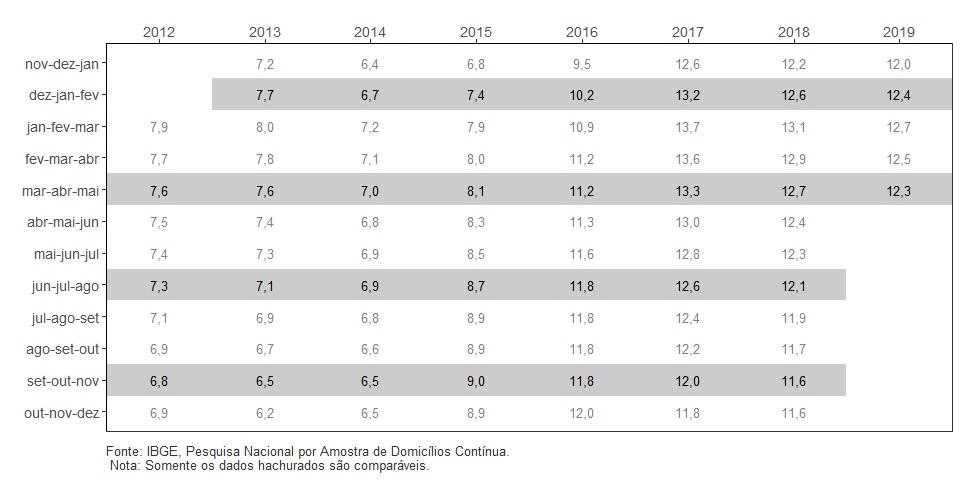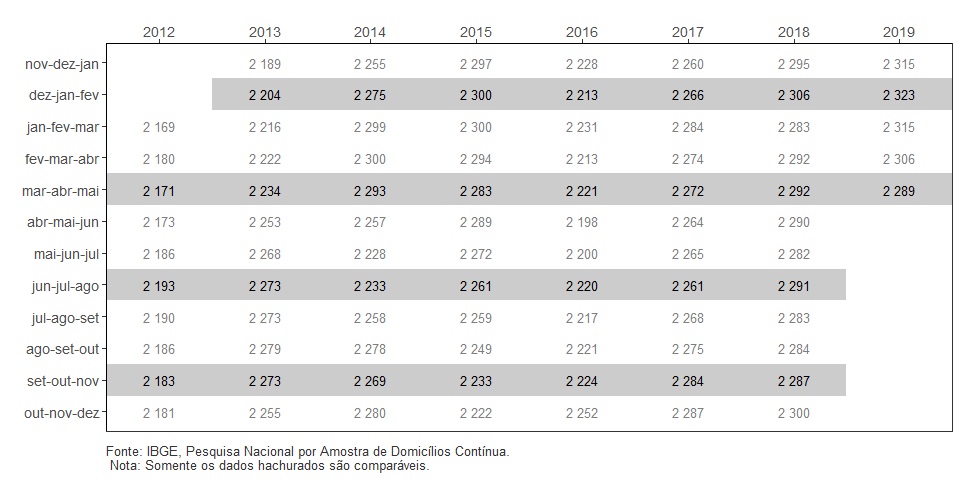Continuous PNAD: unemployment rate is 12.3% underutilization rate reaches 25.0% in the quarter ended in May 2019
June 28, 2019 09h00 AM | Last Updated: July 03, 2019 10h34 AM
In the quarter ended in 2019, the unemployment rate (12.3%) stayed stable in relation to the quarter from December 2018 to February 2019 (12.4%) and fell in the comparison with the same quarter of 2018 (12.7%).
| Indicator / Period | Mar-Apr-May 2019 | Dec-Jan-Feb 2019 | Mar-Apr-May 2018 |
|---|---|---|---|
| Unemployment rate | 12.3% | 12.4% | 12.7% |
| Underutilization rate | 25.0% | 24.6% | 24.6% |
| Usual real earnings | R$2,289 | R$2,323 | R$2,292 |
| Change of the usual real earnings in relation to: | -1.5% (drop) | -0.2% (stability) | |
The unemployed population (13.0 million persons) was statistically stable both against the previous quarter and the same quarter a year ago.
The employed population (92.9 million persons) grew in both comparisons: 1.2% (1,067 thousand more persons) over the previous quarter and 2.6% (2,361 thousand more persons) in comparison with the same period in 2018.
The population out of the workforce (64.7 million persons) fell (-1.2%) over the previous quarter (777 thousand less persons) and remainded stable over the same quarter a year ago.
The labor underutilization compound rate (25.0%) equaled the series record, rising in both comparisons: over the previous quarter (24.6%) and over the same quarter of 2018 (24.6%).
The underutilized population (28.5 million persons) hit the record of the series started in 2012, with highs in both comparisons: 2.7% (744 thousand more persons) over the previous quarter and 3.9% (1,066 thousand more persons) against the same quarter of 2018.
The number of discouraged persons (4.9 million) hit the record of the series and stood stable in both comparisons. The percentage of the discouraged persons in relation to the population in the workforce or the discouraged was of 4.4%, repeating the series record and keeping the stability in both comparisons.
The amount of employed persons in the private sector with a formal contract (except domestic workers) was of 33.2 million persons, staying stable over the previous quarter and increasing 1.6% (521 thousand more persons) over the same period of 2018. On the other hand, the number of employed persons without a formal contract (11.4 million persons) increased in both comparisons: 2.8% (309 thousand more persons) against the same quarter and 3.4% (372 thousand more persons) in relation to the same quarter of 2018.
The number of self-employed workers (24.0 million persons) is a record of the time series and rose in both comparisons: 1.4% (322 thousand more persons) compared to the previous quarter and 5.1% (1,170 thousand more persons) compared to the same period of 2018.
The average usual real earnings (R$2,289) was 1.5% lower than in the previous quarter and stable compared to the same quarter of 2018. The usual real wage bill (R$207.5 billion) remained stable in relation to the quarter and grew 2.4% (R$4.9 billion more) compared to the same period in 2018.

The unemployment rate was estimated at 12.3% in the mobile quarter from March to May 2019, remaining stable in relation to the quarter of December 2018 to February 2019 (12.4%). In comparison with the same mobile quarter of 2018, when the rate was estimated at 12.7%, the figure was a fall (-0.5 percentage point).
In the quarter from March to May 2019, there were approximately 13.0 million unemployed persons in Brazil. This contingent was stable compared to the quarter of December 2018 to February 2019 and also in the comparison with the same quarter of the previous year.
The composite underemployment rate of the labor force was estimated at 25.0% in the mobile quarter from March to May 2019, remaining at a record level and registering a high in both comparisons, both in relation to the quarter of December 2018 February 2019 (24.6%) and in relation to the same mobile quarter of 2018 (24.6%).
Composite Labor Underutilization Rate - quarters from March to May - 2012/2019 Brazil (%)
In the quarter from March to May 2019, there were 28.5 million underutilized persons in Brazil. This contingent hit the series record and grew 2.7% (plus 744 thousand people) compared to the quarter from December 2018 to February 2019. Compared to the same quarter of 2018, this estimate grew by 3.9% (more than 1066 thousand people underutilized).
The number of time-related underemployed persons was estimated at 7.2 million in the quarter from March to May 2019. There was an increase of 8.8% in relation to the previous quarter (582 thousand more persons). Compared to the same quarter of 2018, this estimate grew 14.2%.
The contingent in the potential workforce was estimated at 8.3 million persons. This population grew by 2.9% (231 thousand more persons) compared to the previous quarter. Compared to the same quarter of 2018, there was an increase of 4.7% (374 thousand more persons).
The contingent out of the workforce was estimated at 64.7 million persons. This population had a reduction (-1.2%, or 777 thousand fewer persons) compared to the previous quarter. Compared to the same quarter of 2018, there was stability.
The contingent of discouraged persons was estimated at 4.9 million in the March-May 2019 quarter, the series record. There was stability in both comparisons. Conversely, the percentage of discouraged persons in relation to the population in the workforce or the discouraged was estimated in 4.4%, being stable in both comparisons.
The workforce (employed and unoccupied) was estimated at 105.9 million people. This population grew 1.1% (998 thousand more people) compared to the previous quarter. Compared to the same quarter of 2018, there was an increase of 2.1% (2.2 million people).
The employed population reached 92.9 million, an increase of 1.2% (1.1 million persons) compared to the previous quarter and a high of 2.6% (2.4 million more persons) compared to the same period of 2018.
The employment-population ratio was 54.5%, up 0.6 pp compared to the previous quarter (53.9%). Compared to the same quarter of 2018, there was an increase of 0.9 pp.
The number of workers in the private sector with a formal contract (excluding domestic workers) reached 33.2 million, with stability over the previous quarter. Against the same quarter of 2018, there was a rise of 1.6% (521 thousand more persons).
The number of workers in the private sector with a formal contract (excluding domestic workers) reached 33.2 million, with stability over the previous quarter. Against the same quarter of 2018, there was a rise of 1.6% (521 thousand more persons).
The self-employed category reached 24.0 million persons, a record in the time series started in 2012. There was a rise of 1.4% compared to the previous quarter (322 thousand more persons). In relation to the same period of 2018, there was an increase of 5.1% (1.2 million more persons).
The employer category (4.4 million persons) was stable in both comparisons, as was the category of domestic workers, estimated at 6.2 million persons.
The group of workers in the public sector (including statutory servants and the military), estimated at 11.5 million persons, grew 2.3% over the previous quarter. Compared to the same quarter of the previous year, there was no statistically significant change.
The average usual real earnings from all jobs of the employed persons was estimated at R$2 289 in the quarter from March to May 2019, a reduction of 1.5% compared to the previous quarter and stability in relation to the same quarter of 2018.
The usual real wage bill from all jobs of the employed persons (R$207.5 billion) was stable compared to the previous quarter and grew 2.4% (R$4.9 billion) over the same quarter of 2018.
Average monthly usual real earnings in the reference month,
from all jobs of employed persons - Brazil - 2012/2019 - (R$)

